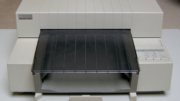I called it. I said a year ago that Windows PCs were coming back in a big way. It was a controversial post and one with a lot of comments to it, when it originally appeared at the older version of this blog. I’ve been vindicated, though, by a recent story saying that PC shipments are actually up this year. It’s hard to know if this is the beginning of a long term trend or just a blip, but it might actually seem like I’m on to something here.
Traditional PCs have been slipping for close to a decade. Once a must-have part of ever home, the PC was a casualty of the Great Recession. While phones and tablets began to seem like must-have pieces of home gear, PCs seemed less and less relevant. They also seemed like an increasing hassle as malware became a growing concern.
Some folks pegged the death of PCs as inevitable when Microsoft released Word and Excel for iOS. Schoolwork seemed like the last province for the traditional keyboard-and-monitor form of computing. Without the need to word process, what other possible need could there be for a virus-ridden, crash-prone bug monster?
If you can’t beat them, join them
One sure reason why PCs have finally begun to climb out of the cellar saleswise is the Microsoft Surface. While the first Surface may have been a “bag of suck” the subsequent versions have gotten better and better. It’s now possible to think of it as both a decent tablet and a surprisingly capable PC. Surface’s climb from obscurity has also enabled other PCs to shine, with innovative designs that emphasize both style and power. All of this of course is right from the Apple playbook. Apple has never held majority share in phones or PCs, and their tablet dominance was short-lived. Still, they have led the way in providing usable, stylish, and high-quality hardware that people actually like using. By taking a hint from Apple, PCs got more interesting and almost surprisingly decent-looking.
Another area where PC makers, and Microsoft specifically, have aped Apple’s moves is in system stability. Windows 10 owes as much to Apple’s version of system design as it does to older versions of Windows. Like Apple’s OS’s, Windows apps now protect themselves from outside intrusion and there’s a store where certified apps can be found. These apps carry the highest security rating, and at the moment it is fairly hard to even infect your computer with malware if you limit yourself completely to Windows Store apps. Of course this means giving up Chrome and several other must-haves, but your system will be as safe and secure as any Mac.
Will the trend continue?
I actually think it will. I think that after a slide almost a decade long, the market for PCs is set to grow again. People have finally outgrown those old PCs from the ’00s and they’re beginning to think there’s a reason to replace them. I don’t think PC shipments will ever again rise to their 1990s highs, but of course back then a traditional computer was the only game in town. Now you can choose a larger phone or tablet, choose a Chromebook or Mac, or just do everything via the web using anything from a watch to a car.
Still, the economy’s good at the moment and there might just be enough reason for people to keep buying PCs. They’re still the preferred way to work at home or school stuff. Plus, they will give you the most complete web browsing experience. There’s something to be said for that. By the way, if you’re looking for the best PC accessories you might want to check out solidsignal.com.





